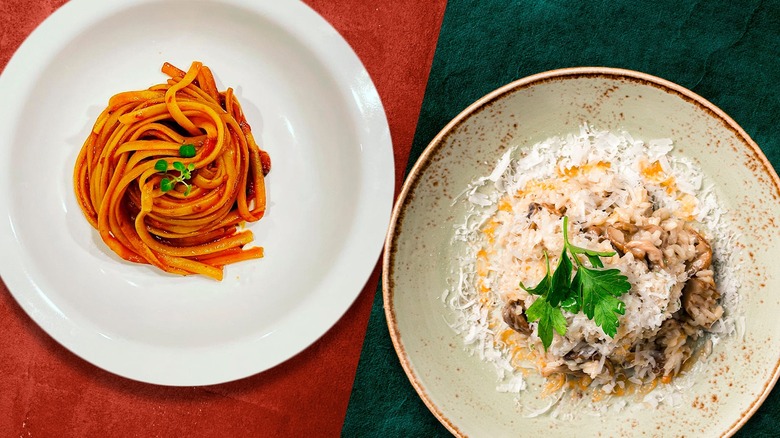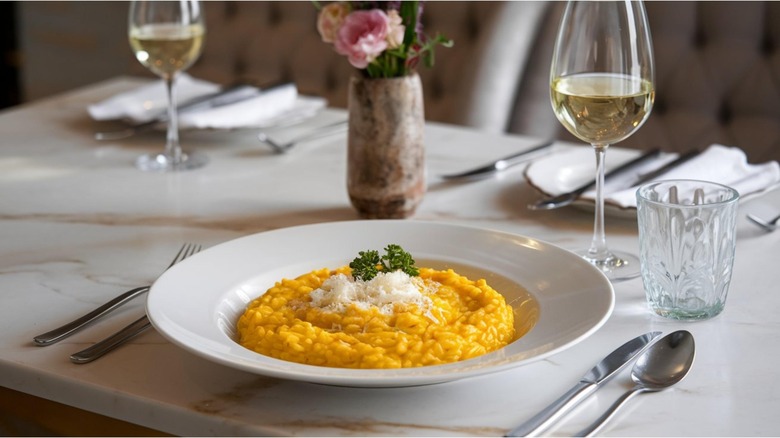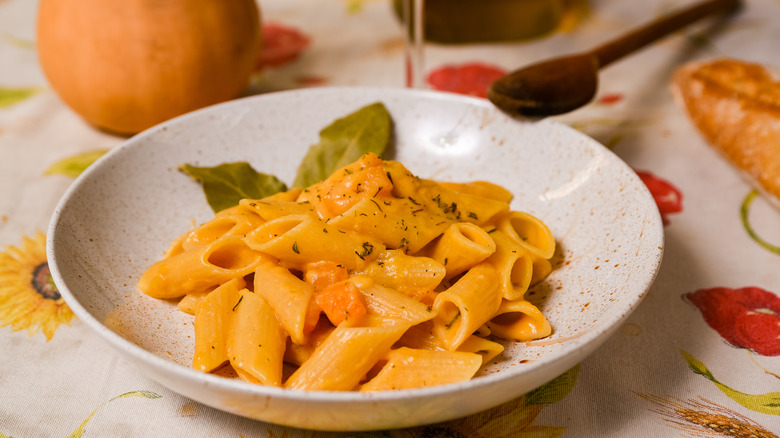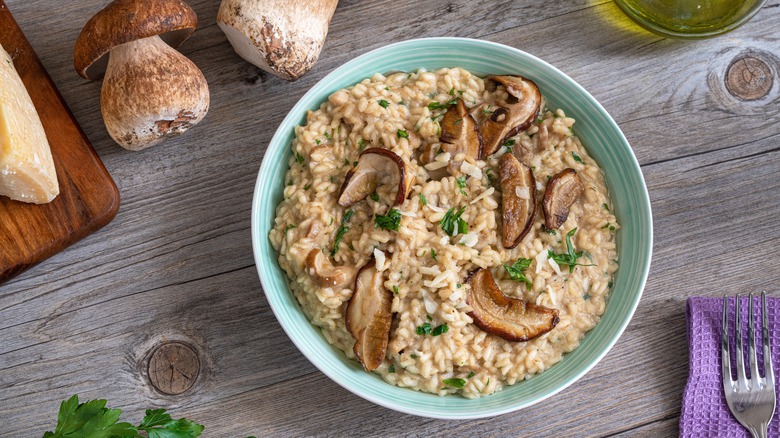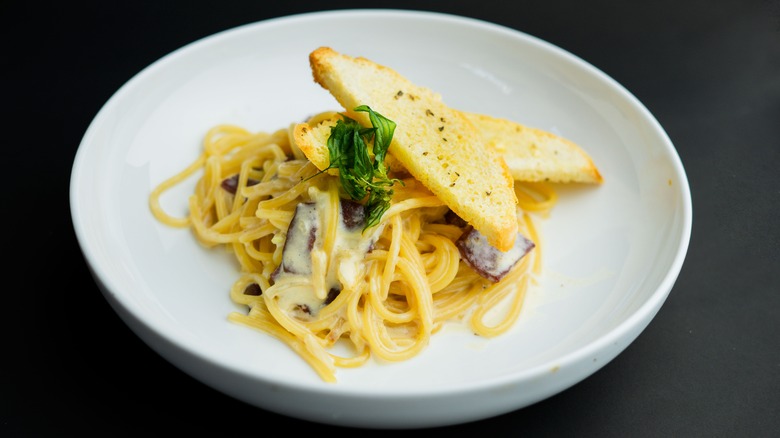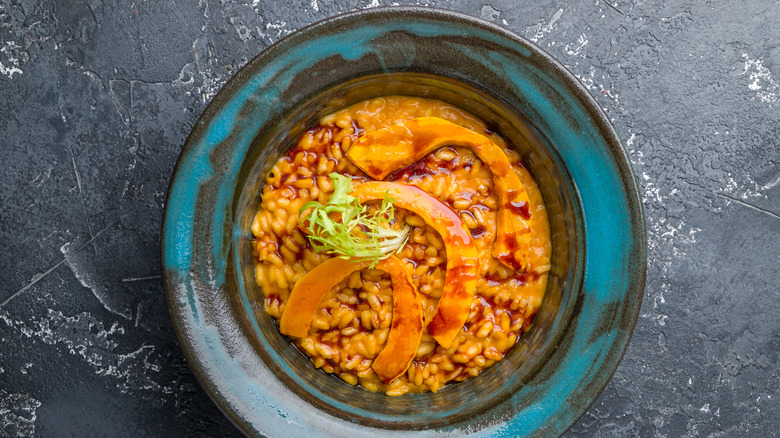Risotto Vs Risottata: What's The Difference?
We may receive a commission on purchases made from links.
Risotto, Italy's most famous rice dish, is pretty much a guaranteed item on Italian menus worldwide. But risottata on the other hand, if you do come across it, usually needs a bit of explaining. Based on the name alone, you'd be right in assuming these dishes are related, but they are somehow both very similar and different than you might think.
A risottata is a pasta dish that's been cooked using the same technique as a risotto — adding liquid little by little to achieve a creamy sauce, rather than boiling in water and adding the sauce at the end. So when reading the recipes, you might find them identical apart from substituting pasta for rice. But presented with the finished dish, you're unlikely to draw any connection between the two. By using pasta, you're going to be changing the whole appearance of the dish, as well as the texture, taste, and cooking time.
What is risotto?
Risotto hardly needs introducing, but as is the case with many things we know well, you might never have stopped to think about what separates risotto from other rice dishes. The secret to the creamy texture lies in both the technique and the type of rice used.
For the best risotto, you need rice that's high in starch, as this is what thickens the sauce. Arborio is traditional, but carnaroli or other short-grain rices are also used (for a taste of authenticity, look for one of Italy's favorites: Riso Scotti). By adding small amounts of liquid at a time, and stirring as you go, you release the starches from the rich which thicken the broth to create a sauce.
Risotto hails from the north of Italy, where you'll find the classic Milanese risotto, flavored with saffron, but risotto flavors vary from region to region. In central Italy, you'll find more earthy options like pumpkin or mushroom risotto, while the south favors seafood. And of course, inventive and non-traditional recipes abound, like this pear and balsamic risotto.
What is risottata?
Risottata, sometimes known as pasta a risotto, takes its name from the verb risottare, which means to cook something in the manner of risotto. The technique is used when you want to create something more like an emulsion, as opposed to something like a traditional pasta sauce, especially those that already contain a thickening element, like carbonara.
Where risottata really has the upper hand when compared to risotto, is that you can use it with almost any pasta shape, allowing you to create a wider variety of dishes. It will create anything from a velvety linguine vongole to a simple penne arrabiata.
While risotto has become a household name, risottata hasn't found the same level of fame. However, you could argue that it's a technique, rather than a dish, so your extra creamy pasta dish may have been cooked risottatura without it being labeled as such. A Puglian dish known as spaghetti all'assassina uses the same technique but is cooked past where you would cook a risottata, to the point where some parts of the spaghetti become charred and crunchy.
Risotto is usually gluten-free
Going to an Italian restaurant can be a fairly heartbreaking experience for anyone with a gluten intolerance, but a dish of risotto is typically a welcome oasis in a sea of pizza and pasta. That said, while rice itself is naturally gluten-free, you do need to check the other ingredients. Bouillon is a common ingredient we assume to be gluten-free, but isn't always. It also means skipping crunchy toppings like pangrattato.
In theory, you could absolutely use gluten-free pasta to make a celiac-friendly risottata, but you'll need to do a little experimenting to get the right results in terms of texture. Even the best gluten-free pasta doesn't always behave like pasta made from wheat flour. Although gluten-free pasta has the starch required to thicken the sauce, it can dry out faster than regular pasta and often sticks together while cooking. Depending on what the pasta is made from, the cooking times will also vary widely.
Risottata can require an extra step
Now that you know the basics of how to cook a risottata, you're probably wondering how you're going to get your dry spaghetti to arrange itself neatly into the bottom of the saucepan. The truth is, you can't. While risottata is in theory a one-pot dish just like its namesake, it all depends on the type of pasta you use.
If you're using any long pasta like spaghetti or bucatini you'll need to blanch it in boiling water for two to three minutes first. This will make it malleable enough to fit in the pot without breaking, as well as speed up the cooking process. Just be careful not to do anything more than a quick blanch, or the pasta will be overcooked before it has the chance to soak up flavors and create that creamy emulsion that you're looking for. For smaller pasta shapes, you can skip this step, and make the dish exactly as you would a risotto, sauteing the dried pasta along with the oil and onions before you start spooning in the hot broth.
Risotto takes longer to make
Despite the extra step that might be required to make a risottata, you'll generally need to set more time aside to make a risotto. Though some chefs claim you can get a good plate together in as little as 20 minutes, most recipes will tell you to allow at least 30 to 40 minutes to get the liquid absorbed and the rice to the perfect creamy texture.
Risottata comes together faster simply because pasta has a quicker cooking time than rice. But before you get excited to think you can whip this up in under 10 minutes, be aware that it will take longer than what the pasta packet tells you. Because the pasta is simmering rather than boiling in water, you'll need around 15 minutes to get it to al dente, depending on the shape and whether it was pre-blanched.
These timings both assume that you have all the other ingredients ready to go. If you're making something like a roasted garlic and butternut squash risotto (or risottata), you'll need to allow some additional prep time, so why not open a bottle of wine and make an event of it?
